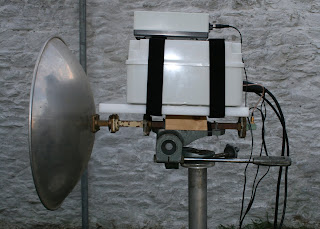I hope your new years resolution to be a good radio experimenter
and QSL 100% is still going strong and that you have let your QSL sub manager know your special event call sign, or that you have passed the Morse code test and that your old call sign QSL cards can be sent toEI???.
Anyway I digress - back to ATV.The project in this months Echo Ireland is one that was started early last year when after a meeting I had with Michael EI5GG,and Mark EI9FX. It was decided that we should make some ATV gear that was a bit more portable, sturdy and waterproof,with a bit of room for additions. Also important are a bit more finger friendly fittings.
 |
| Photo 1 |
As I mentioned in a previous x tract I just don’t go /p in the good weather and with cold and/or wet hands it does make connectingfittings more difficult.
As you /P’ers know, metal gets cold and as I was dealing witsmall nuts (I did say it was cold) and bolts, I decided to use some larger fittings even if they may be regarded as old hat.They are more robust and they end with the flange with a hole in each corner and a threaded fitting collar the other end (See under the Tx/Rx in photo # 2).
In photo 1, the 10 GHz Tx/Rx can been seen with the top off and the parts labelled .
The 2.4 GHz Tx unit has an output of 10mw and the frequency is adjustable by a row of dip switches to give you the frequency you need.Some of the components are bolted down onto a sheet of brass and some are soldered to the brass sheet. This was done to help with heat dissipation. A disadvantage of soldering components to the sheet is if the
upgrades are bigger you may have a major rebuild on your hands . Sure is that not the crux of home brew equipment builder .
Some of the components I used came from the Friedrichshafen rally in Germany
 |
| Photo 2 |
(I mentioned the traders in a previous Echo Ireland) and others from stock and the brass sheet or shim came from a local engineering shop.Maybe I will bring some of my surplus stock to some of the rallies this year and any other info I have.The article in this months Echo Ireland is not a construction article, just a few notes and pictures of one of my home construction projects.Who knows, maybe in a future Echo Ireland I will go into more detail The 10 GHz Tx/Rx is fitted with a 40cms wide dish and within
a few moments I can put the larger 75cms wide dish for a narrower beam width.
The only hole I drilled in the project box was for an SMA panel mount fitting to connect the cable to the dish which has a waveguide to SMA adapter bolted onto it .As you can see in photo 2, I have connected some waveguide to the top of a tripod.
The tripod has a large platform on top of it for bolting the waveguide to it and the collar connectors on each end and it is ready to go portable .The Tx/Rx is held onto the tripod by Velcro strapping for the moment but I am looking into some kind of bonding agent to attach to the base of the project box and a metal plate with some form of connections to attached to the tripod.
Connectors
 On the subject of connections, the most common of ATV aerial fittings I have come across on the Tx and Rx boards are SMA and N types.There are various types of connectors you can get to adapt to SMA or N type if you have a different type of termination.See photo 3 for some of the different types I have come across on my travels. Some are panel mount back to back types, others
On the subject of connections, the most common of ATV aerial fittings I have come across on the Tx and Rx boards are SMA and N types.There are various types of connectors you can get to adapt to SMA or N type if you have a different type of termination.See photo 3 for some of the different types I have come across on my travels. Some are panel mount back to back types, othersthe same with a small amount of coax between ends and others are just the in-line back to back type.Even the wave guide can come with some different flange ends,the square type with bolt holes in each corner or the round type that use a couple of threaded rings to secure each other (although this type of termination is now regarded as old hat).
The wave guide is also available new in various lengths with or without the flanges on them .The lengths of wave guide are available in brass or copper.You will also get various lengths that are flexible and others that are semi-rigid and of various angles to suit your specifications.The flexible and semi-rigid would in most cases have the flanges moulded on to the ends .
Thanks to Thos EI2JD once again for taking the photos for me.
73 and good DX to you.
Pat EI2HX

No comments:
Post a Comment